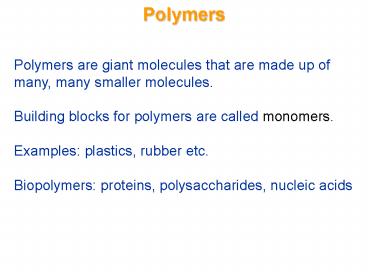Polymers - PowerPoint PPT Presentation
1 / 32
Title:
Polymers
Description:
Polymers are giant molecules that are made up of many, many ... For example, Bakelite; used for adhesives, moulded. parts and coatings: Phenol. formaldehyde ... – PowerPoint PPT presentation
Number of Views:95
Avg rating:3.0/5.0
Title: Polymers
1
Polymers
Polymers are giant molecules that are made up of
many, many smaller molecules. Building blocks
for polymers are called monomers. Examples
plastics, rubber etc. Biopolymers proteins,
polysaccharides, nucleic acids
2
Polymers
Biopolymers
Proteins
- Basic building blocks are amino acids
- Amino acids linked together into proteins by
amide groups
- Peptide bonds formed by condensation reactions
between two - amino acids.
e.g. Alanine Glycine
Gly
Ala
Gly-Ala
3
Polymers
Biopolymers
4
Polymers
Amino acids
5
Polymers
Polysaccharides (Carbohydrates)
- Monosaccharides linked together by ether-bridges
Representative segment of cellulose a tough
fibre.
6
Polymers
Nucleic acids
Composed of
H3PO4 molecule
Organic base
5-C sugar
7
Polymers
In order to get a polymer formed we need a
bifunctional molecule.
8
Polymers
Addition Polymerization Example ethylene
H2CCH2, can polymerize by opening the CC ? bond
to form CC ? bonds with adjacent ethylene
molecules (with the help of radicals). The
result polyethylene. This is called addition
polymerization because ethylene molecules are
added to each other.
9
Polymers
Step 1 Initiation generation of radicals from
catalyst
Step 2 radical adds to ethylene and
polymerisation starts
10
Polymers
11
Polymers
12
Polymers
This is the repeat unit
13
Polymers
14
Polymers
repeat unit
15
Polymers
Condensation Polymerization Condensation
Polymerization molecules are joined by the
elimination of a small molecule (e.g.
water) Example of condensation
polymerization formation of nylon.
16
Polymers
17
Polymers
Another example of a condensation polymerisation
is the formation of nylon 6. Used for clothing
and mountaineering ropes amongst others
18
Polymers
19
Polymers
20
Polymers
21
Polymers
22
Polymers
Types of Polymers Plastic
Materials that can be formed into shapes by
application of heat and pressure.
Thermoplastics
- Hard at room temp.
- Become soft viscous when heated. ? can be
- shaped more than once.
- Little or no cross-linking ? individual chains
can slip - past each other.
- E.g.s include polyethylene, nylon, polystyrene.
23
Polymers
Thermosetting resins
- Become highly cross-linked when heated. ?
solidify - into a hard, insoluble mass.
- Can only be shaped once, polymerisation
irreversible. - Can withstand high temperatures.
- For example, Bakelite used for adhesives,
moulded - parts and coatings
Phenol
formaldehyde
24
Polymers
Elastomers
- Have the ability to stretch out spring back to
their - original shapes.
- Have a modest amount of cross-linking.
- Polymer chains have irregular shapes.
- Most common example is natural rubber
25
Polymers
Structure and Physical Properties of
Polymers Polymer chains tend to be flexible and
easily entangled or folded due to free rotation
around the CC single bonds. Some regions of the
polymer, may however, display a more ordered
arrangement of chains than other regions
26
Polymers
Structure and Physical Properties of
Polymers The degree of crystallinity is a
measure of the extent of such ordering. More
ordering in a polymer denser, harder, less
soluble polymers that are more resistant to heat.
e.g.
Properties of PE as a Function of Crystallinity.
27
Polymers
Structure and Physical Properties of
Polymers Stretching or extruding a polymer can
increase crystallinity. Degree of crystallinity
is also determined by average molecular
mass Low density polyethylene (LDPE) has an
average molecular mass of 104 amu (used in
plastic wrap) High density polyethylene (HDPE)
has an average molecular mass of 106 amu (used in
milk cartons).
28
Polymers
Structure and Physical Properties of Polymers
LDPE
- Obtained by polymerization of ethylene at high
pressure - and high temperature.
- Polymer chains have irregular branches and
cannot pack - together in an ordered way.
- Result LDPE is an open polymer of low density
and little - mechanical strength.
29
Polymers
Structure and Physical Properties of Polymers
HDPE
- Polythene can also be prepared catalytically at
lower - pressures and temperatures.
- Result regular non-branched chain polymer which
is highly - ordered or crystalline.
- HDPE is tough and strong and the ordered
structure means - that it has higher density.
30
Polymers
Structure and Physical Properties of Polymers
Polyethylene is a very versatile material its
properties can be fine tuned by varying
31
Polymers
- Cross-Linking Polymers
- Bonds formed between polymer chains make the
polymer stiffer. - Natural rubber is too soft and chemically
reactive to make a useful material. - By vulcanizing the rubber (cross-linking the
polymer chains) useful materials are made. - Rubber is usually cross-linked with sulfur.
- Cross-linked rubber is stiffer, more elastic and
less susceptible to chemical reaction.
32
Polymers
Cross-Linking Polymers































